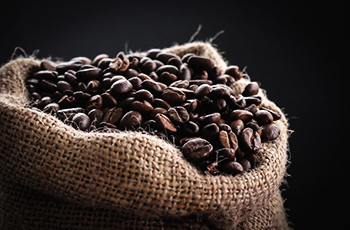The Coffee Bean

The Coffee Arabica tree is an evergreen with broad, shiny, arrowhead shaped leaves 3 to 6 inches long. The trees bear small, white flowers that cluster at the base of the leafs and grow in pairs on either side of the tree's central stem.
Coffee trees grow to a height of 14 to 20 feet. Growers keep them pruned to about 6 feet to simplify picking the beans and nourish heavy bearing of berries.
The first visible sign of a coffee tree's maturity (around 5 years old) is the appearance of small white blossoms which fill the air with the heady aroma of jasmine and orange.
The mature coffee tree's small oval berries are about the color and size of a small cherry. Inside the skin and pulp are two coffee beans with their flat sides together.
Each tree can produce between 1 and 12 pounds of coffee per year, depending on soil, climate, and many other factors. The plants are propagated either from seed or from cuttings.
Arabica trees grow best in conditions where there are no extreme temperatures in fertile, well-watered, well-drained soil. Since the trees need partial sun, some growers plant shade trees or make protective trellises to shade the coffee trees.
Arabica trees grown at altitudes between 4,000 to 4,500 feet, usually produce coffee with a "hard bean". Coffee grown above 4,500 feet is referred to as "strictly hard bean".
The colder climate encourages a slower-maturing bean, and the beans are harder and denser than other beans and are more desirable.
Coffee Robusta grow on a species of coffee trees that were first discovered growing wild at low altitudes in Uganda in the late 19th century.
Robusta's generally grow at lower altitudes and warmer temperatures than the Arabica's and are produced in the eastern hemisphere exclusively. Robusta's produce a less characteristic "coffee" taste than the Arabica's.
Coffee Robusta tends to be a hardier, more disease-resistant bean which are less expensive to maintain and produce a higher yield than the Arabica's. Consequently Robusta's are used for the less expensive canned and instant coffees.
Coffee Liberica is comparable to Coffee Robusta, however, only a few percent of all coffee comes from this low growing west African plant.
Preparing Coffee Beans
Once coffee is picked, it can be prepared either by a "dry" method, which produces what is called natural coffee, or by the "wet" method, which produces what is known as "washed coffee".
Dry Method: The berries are dried, either by the sun or in a mechanical dryer. The hard, shriveled husk is removed from the bean by machine, soaking and washing with hot water, or by using either a grindstone or mortar and pestle.
Wet Method: Most of the covering is removed from the bean before it is dried leaving the beans covered with a sticky substance.The beans are then fermented in large tanks by softening them in water, allowing natural enzymes to digest the sticky substance from the bean.
The coffee is washed and dried either by the sun in open terraces or in large mechanical dryers.
Following preparation by either method, 2 thin layers still remain on the bean: the parchment or pergamino and the silver skin. A huller rubs these 2 layers off.
The last step in processing is cleaning. With most high-quality coffees, the beans are placed on conveyor belts or trays and examined by workers who remove defective beans, sticks, dirt, and other debris. The very best coffees may be cleaned twice.
Coffee Grading
The beans are then graded and roasted. Grading is based on 4 criteria:
- Size of the bean
- Country and altitude
- Preparation and the quality of the picking
- Taste known as "cup quality"
The government of the growing country imposes grading standards to encourage and support quality and reassure foreign buyers. Coffee beans may be subject to another grading or sorting after they reach the United States.
A large part of what makes specialty coffees special is the tremendous extra care taken in the grading of the beans. Even a single defective bean can taint the flavor of an entire pot or pound of coffee, so repeated, meticulous sorting both electronically and by hand are used.
Coffee Bean Roasting
Roasting: The process of turning green coffee beans over heat to force moisture out, bring volatile oils closer to the surface and release the essence of the bean's flavor.
The beans are heated in rotating, horizontal drums that provide a tumbling action to prevent uneven roasting or scorching. Temperatures for roasting range from 380° to 425° Fahrenheit. Precise temperature and timing make the difference between an excellent roast and burnt beans.
Roasting changes the chemistry of the bean by converting the starches to sugars, known as "developing" the bean. During the roasting process, most of the moisture is cooked off and the beans lose 18 - 20 % of their weight.
However, the beans gain smoothness, a caramel taste, and a bitter edge. During the roasting process, the beans actually plump up to double their size. Once roasted, the beans require rapid cooling.
Coffee that is neither roasted long enough nor hot enough to bring out the oil has a pasty, nutty, or bread-like flavor.
Coffee roasted too long or at too high a temperature is thin-bodied, burned, and industrial-flavored.
Coffee roasted too long or at too low a temperature has a baked flavor.
Beans can be roasted at home by using an ordinary frying pan. Stir often or the beans will burn. A hot-air popcorn popper also does very well.
The temperature is just right for roasting coffee, and the motion of the air will keep the beans moving quickly so they don't scorch.
At first, the beans will be too heavy for the hot air to move them, so stir them constantly until they start moving.